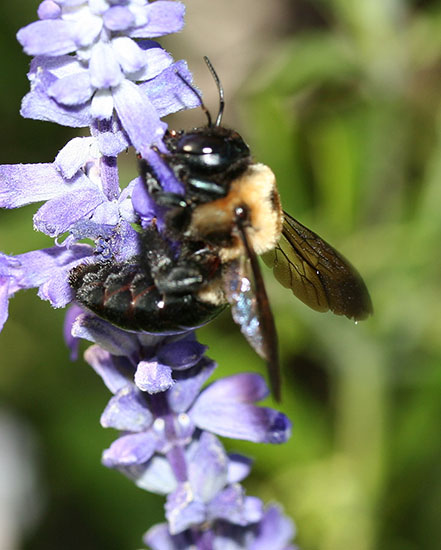Issue 9, June 21, 2013
Pesticide Concerns
It is important when trying to keep landscapes looking as good as possible to be aware of the consequences of some of your actions. Perhaps the likeliest situation where unintended consequences can result is in insecticide and other pesticide applications.
This was brought to bear last week when The Oregonian newspaper reported a major bumblebee kill in an Oregon shopping center parking lot apparently from an illegally timed application of Safari (dinotefuran) to linden trees. There are estimates of 25,000 bumblebees, important pollinators, being killed due to the insecticide application being applied during bloom time, which is specifically prohibited on the pesticide label. The news story if posted at http://www.dailykos.com/story/2013/06/20/1217444/-Massive-bumblebee-kill-in-Oregon-pesticide-spray-suspected

Carpenter Bee Adult on phlox
A similar concern is the application of imidacloprid (Merit, Xytect, others) to control Japanese beetles and other insects on linden. In some plants, imidacloprid apparently does not enter the blossoms, but it does in many plants. It is known that it enters linden flowers, and this tree blooms during July when Japanese beetles are causing the most damage. Linden is perhaps the most favored tree by Japanese beetles, commonly severely damaging the foliage on the upper one-third to one-half of even large trees. Even though imidacloprid remains in trees for slightly over one year after soil or trunk injection, higher levels of the insecticide are likely in the first few weeks after application, coinciding with Japanese beetle attack and flower production.
Research has been conducted in Indiana and other locations showing that clothianidin and thiamethoxam applied to corn and drifting to other plants has a deleterious effect on honey bees. Other research has linked imidacloprid to honey bee and bumblebee reductions. Dinotefuran, imidacloprid, clothianidin, and thiamethoxam are all chemically related and are in the same insecticide class, the neonicotinoids. These insecticides are currently being heavily scrutinized with reductions in use likely to occur.
Dinotefuran has been previously looked at for links to long-term bee reduction and not been found to be a problem. Results on imidacloprid are mixed. Clothianidin and thiamethoxam have been shown to be of greatest concern. These two insecticides are only lightly used on turf and ornamental plants. Review articles that I have written on this situation can be found at http://web.extension.illinois.edu/ipr/#123485, http://web.extension.illinois.edu/ipr/#123486, http://web.extension.illinois.edu/ipr/i8339_829.html#119727, http://web.extension.illinois.edu/ipr/i8262_829.html#118905.
Author:
Phil Nixon